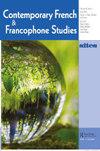“We must leave traces”: Media and Memory in Two Graphic Novels
IF 0.2
4区 文学
0 LITERATURE, ROMANCE
引用次数: 0
Abstract
Abstract At the height of the Spanish Civil War, over 450,000 Spanish citizens fled to France in an exodus known as the Retirada. Multimediality has long marked representations of this history: among its first accounts were illustrated texts by refugees held in French detention camps, and many contemporary works about this period integrate a similar interplay of words and images. This article explores two French graphic novels about the Retirada and the intergenerational transmission of its memory: Alain Munoz’s D’ailleurs (2017) and Henri Fabuel and Jean-Marie Minguez’s Exil (2013). Drawing upon Maurice Halbwachs and Paul Ricœur’s theories of memory, I argue that these texts’ multimedia and multigenre approach—involving not only the interaction between text and image, but also letters, family photographs, and different modes of storytelling—reflects a similarly dynamic interdependence between individual and collective memory. I also consider a 1939 refugee-run review, Barraca, to trace this intersection of media and memory back to the Retirada’s very first publications.“我们必须留下痕迹”:两部平面小说中的媒介与记忆
摘要在西班牙内战最激烈的时候,超过45万西班牙公民逃亡到法国,这场逃亡被称为Retirada。多媒体长期以来一直是这段历史的标志性表现:在其最初的描述中,有被关押在法国拘留营的难民的插图文本,许多关于这一时期的当代作品融合了类似的文字和图像的相互作用。本文探讨了两部关于雷蒂拉达及其记忆代际传递的法国平面小说:阿兰·穆尼奥斯的《戴勒》(2017)和亨利·法布尔和让-马里·明格斯的《流放》(2013)。根据Maurice Halbwachs和Paul Ricœur的记忆理论,我认为这些文本的多媒体和多类型方法——不仅涉及文本和图像之间的互动,还涉及信件、家庭照片和不同的讲故事模式——反映了个人记忆和集体记忆之间类似的动态相互依存关系。我还考虑了1939年难民经营的一篇评论《Barraca》,将媒体和记忆的交叉点追溯到Retirada的第一份出版物。
本文章由计算机程序翻译,如有差异,请以英文原文为准。
求助全文
约1分钟内获得全文
求助全文
来源期刊

Contemporary French and Francophone Studies
LITERATURE, ROMANCE-
CiteScore
0.30
自引率
0.00%
发文量
43
期刊介绍:
An established journal of reference inviting all critical approaches on the latest debates and issues in the field, Contemporary French & Francophone Studies (formerly known as SITES) provides a forum not only for academics, but for novelists, poets, artists, journalists, and filmmakers as well. In addition to its focus on French and Francophone studies, one of the journal"s primary objectives is to reflect the interdisciplinary direction taken by the field and by the humanities and the arts in general. CF&FS is published five times per year, with four issues devoted to particular themes, and a fifth issue, “The Open Issue” welcoming non-thematic contributions.
 求助内容:
求助内容: 应助结果提醒方式:
应助结果提醒方式:


